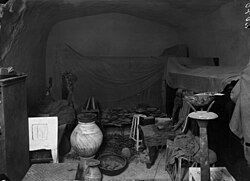
Back مقبرة غا Arabic Grab von Cha und Merit German TT8 French TT8 Hungarian Tomba di Kha e Merit Italian
| Theban tomb TT8 | |
|---|---|
| Burial site of Kha and Merit | |
 The burial chamber of Kha and Merit as discovered in 1906 | |
| Coordinates | 25°43′44″N 32°36′03″E / 25.7289°N 32.6009°E |
| Location | Deir el-Medina, Theban Necropolis |
| Discovered | Before 1818 (chapel) 15 February 1906 (tomb) |
| Excavated by | Ernesto Schiaparelli (1906) Bernard Bruyère (1924) |
| Decoration | Offering and feasting scenes (chapel) Undecorated (tomb) |
| Layout | Straight axis |
← Previous TT7 Next → TT9 | |
The tomb of Kha and Merit, also known by its tomb number Theban Tomb 8 or TT8, is the funerary chapel and burial place of the ancient Egyptian foreman Kha and his wife Merit, in the northern cemetery of the workmen's village of Deir el-Medina. Kha supervised the workforce who constructed royal tombs during the reigns of the pharaohs Amenhotep II, Thutmose IV and Amenhotep III (r. 1425 – 1353 BC) in the mid-Eighteenth Dynasty of the early New Kingdom of Egypt. Of unknown background, he probably rose to his position through skill and was rewarded by at least one king. He and his wife Merit had three known children. Kha died in his 60s, while Merit died before him, seemingly unexpectedly, in her 20s or 30s.
The couple's pyramid-shaped chapel has been known since at least 1818 when one of their funerary stele was purchased by the antiquarian Bernardino Drovetti. Scenes from the chapel were first copied in the 19th century by early Egyptologists including John Gardiner Wilkinson and Karl Lepsius. The paintings show Kha and Merit receiving offerings from their children and appearing before Osiris, god of the dead. The decoration has been damaged over the millennia, deteriorating due to structural decay and human actions.
Kha and Merit's tomb was cut into the base of the cliffs opposite their chapel. This position allowed the entrance to be quickly buried by debris deposited by landslides and later tomb construction, hiding its location from ancient robbers. The undisturbed tomb was discovered in February 1906 in excavations led by the Egyptologist Ernesto Schiaparelli on behalf of the Italian Archaeological Mission. The burial chamber contained over 400 items including carefully arranged stools and beds, neatly stacked storage chests of personal belongings, clothing and tools, tables piled with foods such as bread, meats and fruit, and the couple's two large wooden sarcophagi housing their coffined mummies. Merit's body was fitted with a funerary mask; Kha was provided with one of the earliest known copies of the Book of the Dead. Their mummies have never been unwrapped. X-rays, CT scanning and chemical analyses have revealed neither were embalmed in the typical fashion but that both bodies are well preserved. Both wear metal jewellery beneath their bandages, although only Kha has funerary amulets.
Almost all of the contents of the tomb were awarded to the excavators and were shipped to Italy soon after the discovery. They have been displayed in the Museo Egizio in Turin since their arrival, and an entire gallery is devoted to them. This has been redesigned several times.
